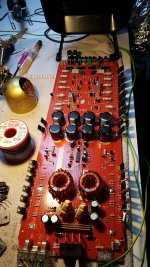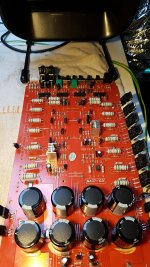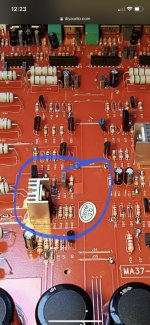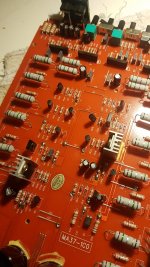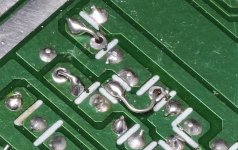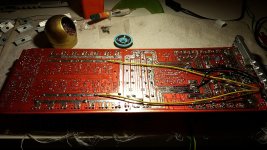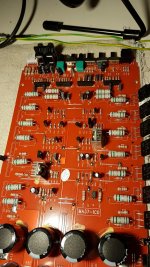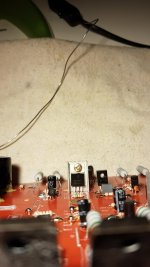Hi guys,
This soundstream amp has a correct working power supply (measured with no rectifiers installed).
The amplifier powers up well (0.8a for 4 sec), and then it instantly draws about 10a+
Nothing else gets hot except for the PS fets.
I removed one side of the output transistors (A1303) and now the amplifier does not draw excessive current. All the A1303 transistors read OK. When soldering one transistor back it is instantly pulling 10a+ again.
Any ideas? It seems like there are no strange voltages on the output transistor connections which could cause it.
This soundstream amp has a correct working power supply (measured with no rectifiers installed).
The amplifier powers up well (0.8a for 4 sec), and then it instantly draws about 10a+
Nothing else gets hot except for the PS fets.
I removed one side of the output transistors (A1303) and now the amplifier does not draw excessive current. All the A1303 transistors read OK. When soldering one transistor back it is instantly pulling 10a+ again.
Any ideas? It seems like there are no strange voltages on the output transistor connections which could cause it.
Attachments
You probably have shorted drivers for the outputs .
It appears you have a burned resistor .
So more then likely a out of tolorance resistor and bad driver transistors .
Also did you check the outputs to see if any were leaking or did you just check them for shorts
It appears you have a burned resistor .
So more then likely a out of tolorance resistor and bad driver transistors .
Also did you check the outputs to see if any were leaking or did you just check them for shorts
Attachments
Is this a regulated power supply?
What driver IC are they using in the power supply?
Do you know about the terrible design of the board that connects from one side of the board to the other?
What driver IC are they using in the power supply?
Do you know about the terrible design of the board that connects from one side of the board to the other?
The resistor which seemed black on the photo's is not burned. This is a shadow area from the light I have on my desk.
There actually doesn't seem to be visible burned components on the output section.
The PS circuit is driven by a KIA494AP.
Mostly when the output section is causing trouble in this kind of amplifiers I have worked on, there are some strange voltages on the output transistor pins, which give a clue that the drive transistors are dead.
This amplifier doesn't has strange voltages on the output transistor pins.
I tested all the output transistors with a transistor tester. Which gives me the hFE, Ie, Ube
All values seems to be very close in tolerance with eachother.
With terrible board design, do you mean that small metal jumper cables which connects the copper traces with eachother?
There actually doesn't seem to be visible burned components on the output section.
The PS circuit is driven by a KIA494AP.
Mostly when the output section is causing trouble in this kind of amplifiers I have worked on, there are some strange voltages on the output transistor pins, which give a clue that the drive transistors are dead.
This amplifier doesn't has strange voltages on the output transistor pins.
I tested all the output transistors with a transistor tester. Which gives me the hFE, Ie, Ube
All values seems to be very close in tolerance with eachother.
With terrible board design, do you mean that small metal jumper cables which connects the copper traces with eachother?
Attachments
Last edited:
Any point where there is a solder connection on the top AND bottom for any component terminal, the connection is likely to be intermittent. The best solution is to replace the component (or scrape the terminals), solder only on top and make the connection on the bottom to some other point in the circuit. You don't want solder on the top and bottom of the board.
In the attached photo, you can see how the resistor legs are not soldered on the bottom of the board (they were soldered on top) and the leg is soldered to another point.
In the attached photo, you can see how the resistor legs are not soldered on the bottom of the board (they were soldered on top) and the leg is soldered to another point.
Attachments
I actually got the same and second amplifier with the exact same problem.
All the connections are 100% ok and well soldered.
No burned components visible.
When one bank of the output transistors is removed (they all read OK) the amplifier powers up fine without excessive current draw. Also with 100% good and nice solder connections.
Power supply is OK
Rectifiers are OK
It's a problem in the output section. No strange DC voltages on the output transistor terminals
All the connections are 100% ok and well soldered.
No burned components visible.
When one bank of the output transistors is removed (they all read OK) the amplifier powers up fine without excessive current draw. Also with 100% good and nice solder connections.
Power supply is OK
Rectifiers are OK
It's a problem in the output section. No strange DC voltages on the output transistor terminals
Last edited:
I tried to slightly isolate both banks to unsolder the yellow wire on the bottomside of the PCB (this doesn't make a difference)
I unsoldered and tested all the drive transistors of the bank which output transistors are unsoldered (all transistors read ok)
This amplifier has 2 output banks. A bank with A1303 output transistors and a bank with C3284 output transistors.
From each bank, all output transistor gate pins are connected to the single MJE15031G drive transistor (connected to the little heatsink)
Anyone has an idea?
I unsoldered and tested all the drive transistors of the bank which output transistors are unsoldered (all transistors read ok)
This amplifier has 2 output banks. A bank with A1303 output transistors and a bank with C3284 output transistors.
From each bank, all output transistor gate pins are connected to the single MJE15031G drive transistor (connected to the little heatsink)
Anyone has an idea?
Attachments
This amp is a disaster.
I repaired 2 of these amps. Had them perfectly working again, drawing a very healthy amount of current.
They died during my heavy benchtest, both of them.
If you repair it, chance is very big it is still unstable.
The PCB is terrible quality, the soldering is terrible, and it can't handle high temperatures.
The drive circuit is very weak for the power it does.
If you want to try it, try to resolder all the vias/pins with a good quality solder, make sure every component is properly connected. (The best option is the advice from Perry, post #5) Especially those of the output driver transistors. These run very hot in this amp.
Replace the biggest driver transistor without heatsink (I thought the 2SA2690?), and check for all the resistors in the drive circuit if they read ok.
Remove the output transistors and measure if there are no strange DC voltages on the gate vias.
I repaired 2 of these amps. Had them perfectly working again, drawing a very healthy amount of current.
They died during my heavy benchtest, both of them.
If you repair it, chance is very big it is still unstable.
The PCB is terrible quality, the soldering is terrible, and it can't handle high temperatures.
The drive circuit is very weak for the power it does.
If you want to try it, try to resolder all the vias/pins with a good quality solder, make sure every component is properly connected. (The best option is the advice from Perry, post #5) Especially those of the output driver transistors. These run very hot in this amp.
Replace the biggest driver transistor without heatsink (I thought the 2SA2690?), and check for all the resistors in the drive circuit if they read ok.
Remove the output transistors and measure if there are no strange DC voltages on the gate vias.
Last edited:
Hi Perry, will do! Don't know if I will go any further with the info mentioned.
Hey thanks for replying!
I think I will take your advice and advise on non repairable.
Have a great weekend!
This amp is a disaster.
I repaired 2 of these amps. Had them perfectly working again, drawing a very healthy amount of current.
They died during my heavy benchtest, both of them.
If you repair it, chance is very big it is still unstable.
The PCB is terrible quality, the soldering is terrible, and it can't handle high temperatures.
The drive circuit is very weak for the power it does.
If you want to try it, try to resolder all the vias/pins with a good quality solder, make sure every component is properly connected. (The best option is the advice from Perry, post #5) Especially those of the output driver transistors. These run very hot in this amp.
Replace the biggest driver transistor without heatsink (I thought the 2SA2690?), and check for all the resistors in the drive circuit if they read ok.
Remove the output transistors and measure if there are no strange DC voltages on the gate vias.
Hey thanks for replying!
I think I will take your advice and advise on non repairable.
Have a great weekend!
- Home
- General Interest
- Car Audio
- Soundstream LW1-800 excessive current draw
